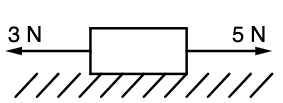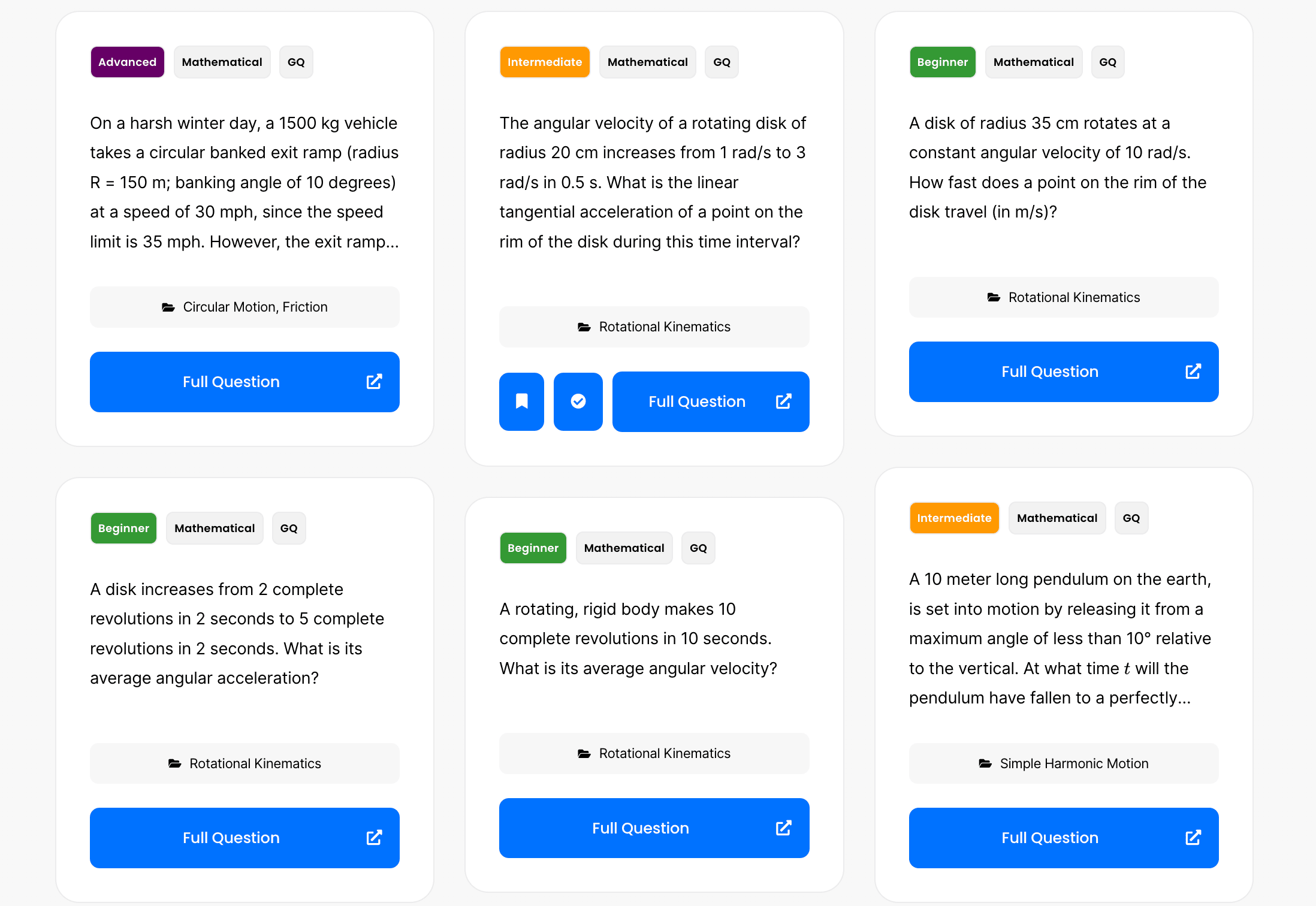| Step | Derivation/Formula | Reasoning |
|---|---|---|
| 1 | F_{\text{friction}} = \mu F_{\text{normal}} | The force needed to set the train in motion, is the force same as overcoming static friction. (F_{\text{friction}}) is the product of the coefficient of static friction (\mu) and the normal force (F_{\text{normal}}). |
| 2 | \mu = 0.741 F_{\text{friction}} = 1.13 \times 10^{5} \, \text{N} |
The coefficient of static friction and the force to overcome static friction are given. |
| 3 | F_{\text{normal}} = \frac{F_{\text{friction}}}{\mu} | Rearrange the friction formula to solve for the normal force. |
| 4 | F_{\text{normal}} = \frac{1.13 \times 10^{5} \, \text{N}}{0.741} | Substitute the known values into the rearranged equation. |
| 5 | F_{\text{normal}} = 1.52456 \times 10^{5} \, \text{N} | Calculate the normal force. |
| 6 | F_{\text{normal}} = mg | Note that the normal force acts opposite to the weight of the train. thus can also set the normal force equal to the weight of the train. |
| 7 | m = \frac{F_{\text{normal}}}{g} | Rearrange the equation to solve for the mass (m). |
| 8 | m = \frac{1.524 \times 10^{5} \, \text{N}}{9.81 \, \text{m/s}^2} | Substitute the calculated normal force from step 5 to find the mass. |
| 9 | m \approx 1.55 \times 10^4 \, \text{kg} | The approximate mass of the train calculated from the given forces and coefficients. |
Phy can also check your working. Just snap a picture!
A block of mass m is accelerated across a rough surface by a force of magnitude F exerted at an angle θ above the horizontal. The frictional force between the block and surface is ƒ. Find the acceleration of the block (as an equation).
A horizontal uniform meter stick of mass 0.2 kg is supported at its midpoint by a pivot point. A mass of 0.1 kg is attached to the left end of the meter stick, and another mass of 0.15 kg is attached to the right end of the meter stick. The meter stick is free to rotate in the horizontal plane around the pivot point. What is the tension in the string supporting the left end of the meter stick?
A 1.5 kg block is pushed to the right with just enough force to get it to move. The block is pushed for five seconds with this constant force, then the force is released and the block slides to a stop. If the coefficient of kinetic friction is 0.300 and the coefficient of static friction is 0.400. Calculate the amount of time that passes from when the force is applied to when the block stops.

The block is moving horizontally at a constant velocity. There are two applied forces on the object as shown in the image. In which direction is the friction force acting on the object?
A 45 kg crate accelerates at 1.65 m/s2 when pulled by a rope with a force of 200 N. Find the angle the rope is pulled at. Friction is negligible.
By continuing you (1) agree to our Terms of Sale and Terms of Use and (2) consent to sharing your IP and browser information used by this site’s security protocols as outlined in our Privacy Policy.
| Kinematics | Forces |
|---|---|
| \Delta x = v_i t + \frac{1}{2} at^2 | F = ma |
| v = v_i + at | F_g = \frac{G m_1m_2}{r^2} |
| a = \frac{\Delta v}{\Delta t} | f = \mu N |
| R = \frac{v_i^2 \sin(2\theta)}{g} |
| Circular Motion | Energy |
|---|---|
| F_c = \frac{mv^2}{r} | KE = \frac{1}{2} mv^2 |
| a_c = \frac{v^2}{r} | PE = mgh |
| KE_i + PE_i = KE_f + PE_f |
| Momentum | Torque and Rotations |
|---|---|
| p = m v | \tau = r \cdot F \cdot \sin(\theta) |
| J = \Delta p | I = \sum mr^2 |
| p_i = p_f | L = I \cdot \omega |
| Simple Harmonic Motion |
|---|
| F = -k x |
| T = 2\pi \sqrt{\frac{l}{g}} |
| T = 2\pi \sqrt{\frac{m}{k}} |
| Constant | Description |
|---|---|
| g | Acceleration due to gravity, typically 9.8 , \text{m/s}^2 on Earth’s surface |
| G | Universal Gravitational Constant, 6.674 \times 10^{-11} , \text{N} \cdot \text{m}^2/\text{kg}^2 |
| \mu_k and \mu_s | Coefficients of kinetic (\mu_k) and static (\mu_s) friction, dimensionless. Static friction (\mu_s) is usually greater than kinetic friction (\mu_k) as it resists the start of motion. |
| k | Spring constant, in \text{N/m} |
| M_E = 5.972 \times 10^{24} , \text{kg} | Mass of the Earth |
| M_M = 7.348 \times 10^{22} , \text{kg} | Mass of the Moon |
| M_M = 1.989 \times 10^{30} , \text{kg} | Mass of the Sun |
| Variable | SI Unit |
|---|---|
| s (Displacement) | \text{meters (m)} |
| v (Velocity) | \text{meters per second (m/s)} |
| a (Acceleration) | \text{meters per second squared (m/s}^2\text{)} |
| t (Time) | \text{seconds (s)} |
| m (Mass) | \text{kilograms (kg)} |
| Variable | Derived SI Unit |
|---|---|
| F (Force) | \text{newtons (N)} |
| E, PE, KE (Energy, Potential Energy, Kinetic Energy) | \text{joules (J)} |
| P (Power) | \text{watts (W)} |
| p (Momentum) | \text{kilogram meters per second (kgm/s)} |
| \omega (Angular Velocity) | \text{radians per second (rad/s)} |
| \tau (Torque) | \text{newton meters (Nm)} |
| I (Moment of Inertia) | \text{kilogram meter squared (kgm}^2\text{)} |
| f (Frequency) | \text{hertz (Hz)} |
General Metric Conversion Chart
Example of using unit analysis: Convert 5 kilometers to millimeters.
Start with the given measurement: \text{5 km}
Use the conversion factors for kilometers to meters and meters to millimeters: \text{5 km} \times \frac{10^3 \, \text{m}}{1 \, \text{km}} \times \frac{10^3 \, \text{mm}}{1 \, \text{m}}
Perform the multiplication: \text{5 km} \times \frac{10^3 \, \text{m}}{1 \, \text{km}} \times \frac{10^3 \, \text{mm}}{1 \, \text{m}} = 5 \times 10^3 \times 10^3 \, \text{mm}
Simplify to get the final answer: \boxed{5 \times 10^6 \, \text{mm}}
Prefix | Symbol | Power of Ten | Equivalent |
|---|---|---|---|
Pico- | p | 10^{-12} | 0.000000000001 |
Nano- | n | 10^{-9} | 0.000000001 |
Micro- | µ | 10^{-6} | 0.000001 |
Milli- | m | 10^{-3} | 0.001 |
Centi- | c | 10^{-2} | 0.01 |
Deci- | d | 10^{-1} | 0.1 |
(Base unit) | – | 10^{0} | 1 |
Deca- or Deka- | da | 10^{1} | 10 |
Hecto- | h | 10^{2} | 100 |
Kilo- | k | 10^{3} | 1,000 |
Mega- | M | 10^{6} | 1,000,000 |
Giga- | G | 10^{9} | 1,000,000,000 |
Tera- | T | 10^{12} | 1,000,000,000,000 |
The most advanced version of Phy. Currently 50% off, for early supporters.
per month
Billed Monthly. Cancel Anytime.
Trial –> Phy Pro
A quick explanation
UBQ credits are specifically used to grade your FRQs and GQs.
You can still view questions and see answers without credits.
Submitting an answer counts as 1 attempt.
Seeing answer or explanation counts as a failed attempt.
Lastly, check your average score, across every attempt, in the top left.
MCQs are 1 point each. GQs are 1 point. FRQs will state points for each part.
Phy can give partial credit for GQs & FRQs.
Phy sees everything.
It customizes responses, explanations, and feedback based on what you struggle with. Try your best on every question!
Understand you mistakes quicker.

For GQs and FRQs, Phy provides brief feedback as to how you can improve your answer.
Aim to increase your understadning and average score with every attempt!
10 Free Credits To Get You Started
*Phy Pro members get unlimited credits

By continuing you agree to nerd-notes.com Terms of Service, Privacy Policy, and our usage of user data.